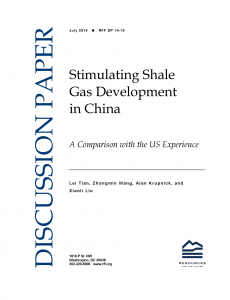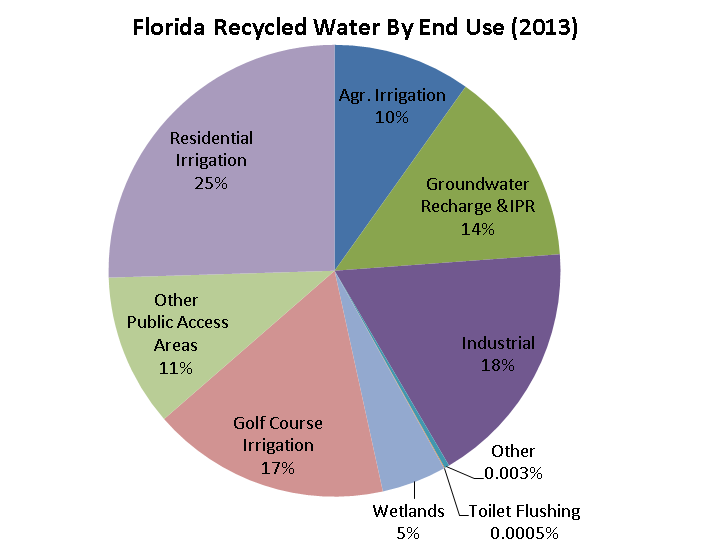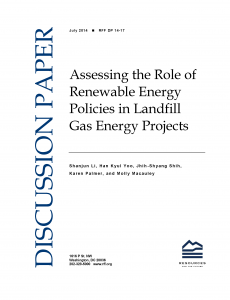Stimulating Shale Gas Development in China: What Lessons to Learn from the US Experience?
 China’s pressing need to reduce coal consumption has created a strong demand for the natural gas trapped in its large shale reserves. The Chinese government has already experimented with a number of policies aimed at promoting shale gas development, but building an industry that can successfully utilize these reserves will be difficult. Although the Ministry of Land and Resources has estimated that China contains about 25.1 trillion cubic meters of recoverable gas, less than favorable geology and infrastructure will make drilling, extraction, and transportation much more challenging than in the United States.
China’s pressing need to reduce coal consumption has created a strong demand for the natural gas trapped in its large shale reserves. The Chinese government has already experimented with a number of policies aimed at promoting shale gas development, but building an industry that can successfully utilize these reserves will be difficult. Although the Ministry of Land and Resources has estimated that China contains about 25.1 trillion cubic meters of recoverable gas, less than favorable geology and infrastructure will make drilling, extraction, and transportation much more challenging than in the United States.
Despite these differences, analyzing the US shale gas experience offers useful insights into how China could overcome the problems inherent in exploiting its hard-to-reach shale reserves. In a new RFF discussion paper, with coauthors Lei Tian and Xiaoli Liu of the Energy Research Institute in Beijing, we do just that. Much like the US experience, China will need to first lower costs through investments in drilling and other innovations in order to become profitable enough to encourage further capital investment. Once an initial innovation stage has produced cost-effective technologies, a second scaling-up stage can increase production to increase profitability and explore new plays. Read More
EPA’s Clean Power Plan: Breaking Down the Building Blocks
In the graph below, we explore two important aspects of EPA’s Clean Power Plan.
- EPA’s state targets for CO2 emissions reductions for existing power plants are in terms of emissions rates—mass of CO2 emissions per unit of electricity generation (lb/MWh). An alternative way to measure emissions reductions (and what matters) is mass terms alone (lb or tons), independent of electricity generation. To examine this, we translate the rate targets into emissions reductions.
- The targets are composed of four building blocks and we show the reductions in these four components. The building blocks breakdown is meaningful because it shows emissions outcomes in the case where some building blocks don’t survive legal challenge.
EPA gives states the option to convert their rate targets to mass targets. Whether states adopt rate or mass targets will be consequential. An emissions rate alone doesn’t pin down how much carbon will be emitted; that depends on the amount of electricity produced during the compliance period (2020-2030). A high rate of economic growth would likely lead to increased power generation. High penetration of electric vehicles would also drive increased generation. More generation means more emissions are possible while still holding the emissions rate constant. Therefore, emissions from the power sector depend on the sector’s growth if the states adopt the rate targets proposed by EPA.
This Week in the RFF Library Blog
Each week, we review the papers, studies, reports, and briefings posted at the “indispensable” RFF Library Blog, curated by RFF Librarian Chris Clotworthy.
EPA’s Clean Power Plan: States’ Tools for Reducing Costs & Increasing Benefits to Consumers
[Press Release] States are well positioned to implement the U.S. Environmental Protection Agency’s (EPA) recently proposed Clean Power Plan, according to a new report from Analysis Group. The report, funded by the Energy Foundation and the Merck Family Fund, was released at the National Association of Regulatory Utility Commissioners’ conference in Dallas. Analysis Group says the study is based on a careful analysis of states that already have experience regulating carbon pollution. It finds that those states’ economies have seen net increases in economic output and jobs… – via The Analysis Group for the Energy Foundation and the Merck Family Fund / by Paul Hibbard, et al.
National Funding of Road Infrastructure
This report examines the funding of roads and highways in Australia, Brazil, Canada, China, England and Wales, France, Germany, Israel, Italy, Japan, Mexico, Netherlands, South Africa, and Sweden. It provides a description of the infrastructure in the jurisdiction, information on the ownership and responsibility of the roads, and taxes or other ways of collecting money to fund the nation’s infrastructure. If applicable, a discussion of reforms or new initiatives is examined… – via Law Library of Congress
This Week in the RFF Library Blog
Each week, we review the papers, studies, reports, and briefings posted at the “indispensable” RFF Library Blog, curated by RFF Librarian Chris Clotworthy.
Clean Energy Services For All: Financing Universal Electrification
[Think Progress] Off-grid renewable energy is one of the cheapest, most effective ways to get electricity to the 1.3 billion people around the world who lack it, the Sierra Club argues in a new report. The report looked at how energy access can be delivered more cost-effectively to the people around the world that need it. The International Energy Agency (IEA) estimates that the world must invest $640 billion over 20 years to ensure global energy access, which is 300 to 500 percent higher than current energy access investments. But the Sierra Club argues that many essential energy services can be delivered more cheaply than the IEA estimates. According to the report, a $500 million investment in energy access will be needed over the next two to three years, and that investment will spur a clean energy services market for the poor valued at $12 billion annually... – via Sierra Club International Climate Program
Consequences of Climate Change Damages for Economic Growth: A Dynamic Quantitative Assessment
This report focuses on the effects of climate change impacts on economic growth. Simulations with the OECD’s dynamic global general equilibrium model ENV-Linkages assess the consequences of a selected number of climate change impacts in the various world regions at the macroeconomic and sectoral level. This is complemented with an assessment of very long-run implications, using the AD-RICE model. The analysis finds that the effect of climate change impacts on annual global GDP is projected to increase over time, leading to a global GDP loss of 0.7% to 2.5% by 2060 for the most likely equilibrium climate sensitivity range… – via OECD
RFF on the Issues: Water recycling in California; Climate change risks
Water Recycling in California
A wastewater treatment plant in Northern California is offering free recycled sewer water to homeowners impacted by the region’s worsening drought conditions. Although recycled water was previously provided for industrial purposes, this is the first time that the plant is providing it directly to residents. More than 10,000 gallons were distributed during the first two weeks of the “innovative” and experimental plan.
In a new blog post, RFF’s Yusuke Kuwayama and Hannah Kamen of the University of Rochester explain that the “yuck factor” often associated with wastewater reuse may not be entirely justified. They note that Florida, a national leader in water reuse (along with California), “currently has no direct potable reuse systems and allocated only 14 percent of its total reused water to indirect potable use in 2013. . . . In fact, most recycled water goes to non-potable uses such as residential greywater, industrial cooling, and irrigation of crops, golf courses, and public access areas.”
Climate Change Risks
A recent Washington Post editorial argued that while scientists are still studying how and where climate change impacts will occur in the future, these uncertainties are “not excuses for doing nothing, or too little, to reduce carbon emissions.” The op-ed notes research results by the Risky Business initiative—which quantified threats such as increases in sea level, storm surges, and energy demand—as an example of data that “should—but probably won’t—snap Congress into action.”
At a recent RFF event, A Discussion of the Independent Risk Assessment for Risky Business: The Economic Risks of Climate Change, members of the Risky Business research team and other experts discussed the methods, data, and significance of the findings for decisionmakers seeking to mitigate future climate change impacts. Video of the event is now available.
Getting Past the “Yuck” Factor: Challenges for Public Acceptance of Recycled Water

Data obtained from the Florida DEP 2013 Inventory Report.
A recent article in Slate ran with the attention-grabbing title “Thirsty West: Why Californians Will Soon be Drinking their Own Pee.” The article was motivated by the planned $142 million expansion of a water reuse facility in Orange County, which will increase the local district’s capacity to take wastewater and convert it into sterile, drinking-quality water. Over the past several decades, increases in water scarcity levels and water demand in cities with growing populations have led to the introduction of similar water reuse projects to help boost supply throughout the United States. At the same time, issues surrounding water reuse have surfaced in the popular press, focusing primarily on the “yuck factor” associated with reusing water for potable purposes.
But before referring to potable reused water as “pee drinking,” it is important to distinguish between two types of potable reclamation and to consider some of the processes involved in potable water reuse. Direct potable reuse (DPR) introduces reclaimed water directly into a potable water distribution system, while indirect potable reuse (IPR) releases reclaimed water post-treatment into natural surface water or groundwater sources as a means of augmenting freshwater supply. Both DPR and IPR require advanced tertiary treatment processes such as membrane filtration and reverse osmosis, but by discharging treated water into surface water or groundwater prior to reuse, IPR utilizes environmental buffers such as rivers, lakes, and aquifers, which have a natural capacity to further purify the water. The Orange County water reuse facility referred to in the Slate article employs IPR by transferring treated water via a 14-mile pipe to recharge basins in Anaheim, where the water percolates through the soil and feeds the county’s aquifer system.
Resources Magazine: Do Driving Restrictions Reduce Congestion? Lessons from Beijing

Source: iStock
By Ping Qin and Jintao Xu
The city of Beijing continues to grow rapidly, not only in population, but also in the number of vehicles on its roads. Although this increased mobility has benefits, the city has become one of the most polluted and gridlocked in the world. Driving restrictions have often been regarded as a silver bullet by various countries and regions seeking to mitigate congestion and pollution problems—including Beijing. However, as has been observed in areas that introduced similar programs, this type of command-and-control policy produces unintended consequences, and Beijing is no exception.
During July 17 to 20, 2007, Beijing became the first city in China to implement a driving restriction policy. It was estimated that this four-day experimental restriction—a trial run for the 2008 Olympic Games—took about 1.3 million automobiles off the roads. After the Olympics, evidence of reductions in traffic congestion and pollution encouraged the government to continue with a similar but less restrictive program. The congestion index—which measures congestion on a scale from 0 to 10—was reduced substantially, shrinking from 7.95 in 2007 to 5.93 in 2009, even though the vehicle population increased by 26 percent in 2007.
Read the rest of this article.
Assessing Landfill Gas-to-Energy Adoption Policies
 Virtually all of us are served by the nation’s vast public and private networks that manage the solid waste we generate—which, in 2012, amounted to about 251 million tons per year, or around 4 pounds per person per day, according to the US Environmental Protection Agency (EPA). From the local city dump that handled waste at the turn of the century, the waste industry has evolved to now include large-scale modern landfills, state-of-the art incinerators, widespread recycling and composting facilities, and a vast network of interstate and international shipments of paper, glass, metal, plastic, and other materials.
Virtually all of us are served by the nation’s vast public and private networks that manage the solid waste we generate—which, in 2012, amounted to about 251 million tons per year, or around 4 pounds per person per day, according to the US Environmental Protection Agency (EPA). From the local city dump that handled waste at the turn of the century, the waste industry has evolved to now include large-scale modern landfills, state-of-the art incinerators, widespread recycling and composting facilities, and a vast network of interstate and international shipments of paper, glass, metal, plastic, and other materials.
RFF researchers have long studied numerous aspects of the sector, including the significant role of local government in relation to private companies in waste management, the effect of Supreme Court and other legal decisions based on the Interstate Commerce Clause in regulating state-to-state shipments of waste, optimal policies for recycling, and the management of e-waste. Among the most recent developments is the emerging role of landfills in helping to manage greenhouse gas emissions. Landfill gas is the third largest anthropogenic source of methane in the United States, estimated by EPA to account for about 17.5 percent of total US methane emissions in 2011. Growing interest in reducing greenhouse gas emissions has led states to promote the capture of some of the 103 million metric tons of carbon dioxide–equivalent (CO2e) from landfills every year in approaches known as landfill gas energy (LFGE) projects.
This Week in the RFF Library Blog
Each week, we review the papers, studies, reports, and briefings posted at the “indispensable” RFF Library Blog, curated by RFF Librarian Chris Clotworthy.
A Realistic View of CNG Vehicles in the U.S.
As U.S. natural-gas prices have fallen and supplies have increased in recent years, compressed-natural-gas (CNG) vehicles are garnering renewed attention. Major automakers, such as Ford and General Motors, have announced plans for a half-dozen different vehicle models powered by CNG. Cummins Westport is introducing a full range of medium- and heavy-duty engines that run on either compressed or liquefied natural gas. Clean Energy Fuels, backed by longtime natural-gas proponent T. Boone Pickens, has opened almost 500 CNG truck-refueling stations as part of its America’s Natural Gas Highway network. Companies that operate large vehicle fleets have also embraced CNG. Waste Management, for example, has said it plans to convert most of its refuse trucks to run on CNG… via – Boston Consulting Group
Climate Change Adaptation: DOD Can Improve Infrastructure Planning and Processes to Better Account for Potential Impacts
[What GAO Found] In its Fiscal Year 2012 Climate Change Adaptation Roadmap, the Department of Defense (DOD) identified climate change phenomena such as rising temperatures and sea levels as potentially impacting its infrastructure, and officials at sites GAO visited or contacted noted actual impacts they had observed. For example, according to DOD officials, the combination of thawing permafrost, decreasing sea ice, and rising sea levels on the Alaskan coast has increased coastal erosion at several Air Force radar early warning and communication installations. Impacts on DOD’s infrastructure from this erosion have included damaged roads, seawalls, and runways. In addition, officials on a Navy installation told GAO that sea level rise and resulting storm surge are the two largest threats to their waterfront infrastructure. For instance, they are concerned about possible storm surge during work on a submarine that will be cut in half while sitting in a dry dock. Officials explained that if salt water floods the submarine’s systems, it could result in severe damage… via – US Government Accountability Office
This Week in the RFF Library Blog
Each week, we review the papers, studies, reports, and briefings posted at the “indispensable” RFF Library Blog, curated by RFF Librarian Chris Clotworthy.
Evolving Business Models for Renewable Energy
…Jointly authored by ACORE members ScottMadden, Sullivan & Worcester, American Clean Energy, RES Americas, Abengoa Solar and Siemens, this resource explores key issues and provides recommendations related to evolving utility and other business models for renewable energy. The report was produced in conjunction with ACORE’s Power Generation and Infrastructure Initiative, and ACORE member contributions to the review provide useful analysis, data, and insight for renewable energy and utility stakeholders… via – American Council on Renewable Energy
Driving Cleaner: More Electric Vehicles Mean Less Pollution
[From Press Release] …Increasing the number of electric vehicles on the road would reduce global warming pollution. Ten states – California, Connecticut, Maryland, Massachusetts, Maine, New Jersey, New York, Oregon, Rhode Island and Vermont – require auto manufacturers to sell electric vehicles in compliance with the Zero Emission Vehicle program. This law will put more than 3.5 million zero emission vehicles on the road in these states by 2025. Even in a scenario with limited growth in renewable energy, this would prevent 4.7 million metric tons of carbon dioxide-equivalent pollution per year compared with conventional cars. That is equal to the annual emissions of almost 1 million of today’s vehicles… via – Environment America

 Subscribe; to our RSS Feed
Subscribe; to our RSS Feed Tweets by @RFF_org
Tweets by @RFF_org 
Recent Comments